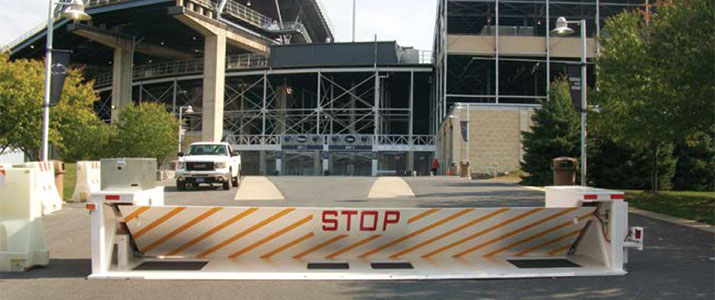
A Crash Course
Creating a vehicular perimeter security system
 Keeping pedestrians safe, protecting structures from accidental or
intentional automobile crashes and force protection—keeping
employees and visitors from harm—have always been a concern.
From pedestrian-filled farmers markets and universities to new
and used car lots, a wide variety of agencies find peace of mind
through the use of barriers, bollards, barricades and crash gates for vehicle-based
physical access control at the perimeter.
Keeping pedestrians safe, protecting structures from accidental or
intentional automobile crashes and force protection—keeping
employees and visitors from harm—have always been a concern.
From pedestrian-filled farmers markets and universities to new
and used car lots, a wide variety of agencies find peace of mind
through the use of barriers, bollards, barricades and crash gates for vehicle-based
physical access control at the perimeter.
Risk Assessment Starts with Physics 101
When evaluating the security risk for a given facility, particular attention must
be paid to the weights and velocities of vehicles that would be used to attempt
penetration into sensitive areas. A vehicle moving toward a barricade has a certain
kinetic energy, the major measure of how much “hitting power” it possesses.
Mathematically, kinetic energy is derived from the vehicle’s velocity and its weight
(mass). On impact, some of this energy is converted to heat, sound and permanent
deformation of the vehicle, so the barricade must absorb the remainder of this
energy if the vehicle is to be stopped.
The amount of remaining energy varies depending on many factors, primarily
the velocity of the vehicle at the moment of impact, as the amount of kinetic energy
posed by a vehicle changes at the square of its velocity. For example, a vehicle
moving at 50 mph has 25 times as much kinetic energy as it would at 10 mph. Thus,
an armored car weighing 30 times as much as a Toyota Corolla and moving at 10
mph would have less hitting power than the Toyota moving at 60 mph.
Because of the relationship between velocity and total kinetic energy possessed
by the vehicle, every effort must be made to force a vehicle to slow down before it
reaches a barricade. The most frequently used technique is to require a sharp turn
immediately in front of a barrier. When vehicle speed is reduced by 50 percent, its
hitting power is reduced by four times; if the speed is reduced by two-thirds, the
force of impact will be reduced nine times.
When designing a way to slow down a vehicle, precautions should be taken so
that the attacking car cannot make a “corner-cutting shot” at a barricade. Often,
only a light post defines a turning point and a speeding car can take it out, usually
without hesitation. Therefore, knolls and other impediments should be considered.
Failing to understand this and not using the proper equipment to counter a
threat may lead to a false sense of security.
Overcoming Common Design Deficiencies
Today’s barriers and bollards are capable of stopping and destroying a truck
weighing up to 65,000 pounds and traveling at 50 mph. Such barricades can be
raised or lowered at will to stop traffic or let it through. In an emergency, the thick
steel plates, or bollards, pop out of the ground within 1.5 seconds.
When integrated properly into a total system including fences, lights, alarms, gates and other security components, vehicle barriers are a key measure in preventing threats to sensitive
resources. It’s important to consider supplemental
gate and fencing reinforcements that may be needed
to optimize vehicle barrier effectiveness.
In designing a barrier system, you must consider
whether to use a passive or active system. Normally,
an active system keeps the barrier in the active or up
position, so it must be deactivated to permit access.
Active systems are preferred to ones that must be activated
to prevent access because they are more secure.
However, linear thinking won’t get you very far
when planning a vehicular perimeter security system.
Straight lines make for faster and easier approaches
for vehicles, so it’s best to create curves on the access
roads to your facility as a natural impediment to
speeding cars or trucks.
Another common planning deficiency occurs
when designers choose non-certified barriers or barricades.
Certified equipment has been tested and
proven to work under extreme conditions, giving
planners the confidence they rely on. Without adequate
testing, there is no assurance that the barrier
will resist the threat. Testing is normally done by an
independent testing company or government agency,
such as the State Department or military. Comprehensive
reports of test results are issued and are
available from the testing agency or manufacturer.
No area is more critical to the vehicle barrier selection
process than testing.
One final area that should not be overlooked is
aesthetics. With today’s smart designs, it is no longer
necessary to choose between form and function;
both can be achieved. Designers are creating secure
environments with more compatible and aesthetically-
pleasing architectural elements. If you visit Washington,
D.C. today, for example, you’ll see landscaped
islands at the north and south entrance drives which
regulate vehicular access. If allowed to drive into the
Capitol complex, you will cross over vehicle control
barriers and bollards at the entrances. Indeed, all exits
at the end of all drives are controlled with barriers,
which pop from the ground when needed.
Similar barriers and bollards are found at refineries,
distribution centers and headquarter offices
of petrochemical and hydrocarbon companies all
around the world.
Putting New Vehicular Threat
Tactics on the Defensive
By their very nature, terrorist attacks are unpredictable,
occurring as a surprise. Staying one step ahead
by identifying vulnerable areas and securing them is
critical to staving off vehicular attacks. That means
being able to deploy security equipment in tough conditions
at a moment’s notice. Fortunately such equipment
now exists in the form of portable, towable and
temporary barriers. These barriers can be deployed
quickly and effectively, even in places where it’s impossible
to excavate for a permanent foundation, such
as the streets of Paris.
Terrorists typically don’t go where they see barricades,
so placing them wherever possible attacks can
happen reduces security risks dramatically. Temporary
barriers can protect facilities while permanent
ones are being built, and they’re even effective for the
long-term where physical conditions preclude permanent
solutions.
There are many types of available portable barriers
and barricades:
Drop arm barrier: Able to be deployed or relocated
for full manual or automatic operation within two
hours, these quick deployment barriers will stop and
destroy a 15,000-pound truck traveling at 30 mph in
less than 20 feet. They secure an entrance roadway
eight to 24 feet in width from vehicle attack.
Portable plate barricades: These provide security
against vehicle-based terrorism or thefts for highcycle
locations such as the entrances to large office
facilities, government agencies and military bases.
Able to be deployed in high-traffic locations for full
manual or automatic operation within two hours,
these quick-deployment, modular barricades feature
a phalanx-type rising plate barrier, mounted within
multiple inertial pods.
The plate barrier lies level to the ground to allow
vehicles to pass and is raised or lowered into position
using a hydraulic cylinder driven by a hydraulic power
unit. The hydraulic pumping unit can be sized to provide
pass-through rates suitable for most inspection
and identification station requirements.
Towed portable crash barriers: Able to be deployed
in 15 minutes, the newest portable, high-security, vehicle
crash barriers can quickly protect facilities and people
from vehicle attacks and accidents. These mobile
crash barriers can be towed into position by a mediumsized
pick-up truck or equivalent. This mobile barrier
operates locally or remotely for guard protection.
Deployment, retrieval and operation are all hydraulic.
These barriers stop and disable a 15,000-pound
vehicle moving at 30 mph. These portable crash barriers
were built for U.S. Federal government security
specialists who wanted a system that could be rapidly
deployed and then operated as a regular security gate
or barrier system. Once positioned, the mobile barricade
is separated from its transporter and lowered
into position by means of a battery-operated hydraulic
power system, which is then used to raise or lower
the barrier for normal or emergency tasks.
Permanent Barriers and Barricades
From parking lot security to stopping vehicular access
at refineries, there are a variety of suitable barricades
available. Solutions include:
- High security barriers are all crash rated in widths
up to 288 inches and up to 38 inches high. Lowered
to allow passage of authorized vehicles, these barriers
are the first line of defense at critical facilities.
- High-security, surface-mounted barricades allow
quick installation into difficult locations such as
parking structure ramps or areas with sub-surface
drainage problems. These crash-rated barricades
are lowered to allow passage of authorized vehicles
and are available in widths up to 288 inches.
- Very high security, shallow foundation
barriers are available for advanced
counter-terrorism applications
in sub-surface conditions that
negate extensive excavations. (This
type of barricade was designed for
the Navy.) Set in a foundation only
ten to 18 inches deep, these shallow
foundation barriers are able to survive
and operate after a 1.2-million
foot pound impact. With its shallow
foundation and aesthetic design,
they are major breakthrough in
high-duty, anti-terrorist barricades.
- Shallow foundation barriers eliminate
concerns about interference
with buried pipes, power lines and
fiber optic communication lines
while reducing installation complexity,
time, materials and corresponding
costs. These types of barriers are
suitable for high water table locations
and areas with corrosive soils.
- Cable beam barricades are available
in hydraulic and manually-operated
models. All are crash rated, with one
version enhanced for higher security
applications. The clear openings
range from 10.5 to 24 feet. One model
is configured as a swing gate for use
where vertical lift is impractical. All
other models are raised to allow passage
of authorized vehicles.
Bollards are Buff,
and Beautiful
Bollard systems operate individually or
in groups of up to ten, and are used for
intermediate level security applications.
Individual bollards are up to 12.75
inches in diameter, up to 35 inches high
and are usually mounted on 3 to 5 foot
centers. Hydraulic versions can be operated
by a variety of control systems
while manual versions are counter balanced
and lock in the up or down position.
All models are crash rated and
lower to allow passage of authorized
vehicles. They are also tested to stop
and destroy an attacking vehicle weighing
10,000 pounds moving at 65 milesper-
hour or a 20,000-pound vehicle
moving at 46 miles-per-hour.
With bollards you can create the
look you want. Ranging from faceted,
fluted, tapered, rings and ripples, colors
and pillars to shields, emblems and
logos, bollards are aesthetically pleasing
and versatile. Ornamental steel trim
can be attached directly to the bollard,
or select cast aluminum sleeves that
slip right over the crash tube. If damaged,
simply slip off the old and slip
on the new. Bollards can also be galvanized
for corrosion resistance, fitted
with an internal warning light for increased
visibility and engineered to suit
high traffic volume.
Protecting perimeters of facilities
is no small responsibility. Knowing
you’ve got the right equipment in
place to secure the facility and prevent
human tragedy brings peace of mind
that no amount of money can buy.
Carefully researching available options
and consulting with experts will
ultimately lead to the
right solution.
This article originally appeared in the August 2014 issue of Security Today.